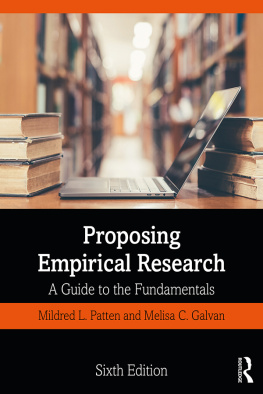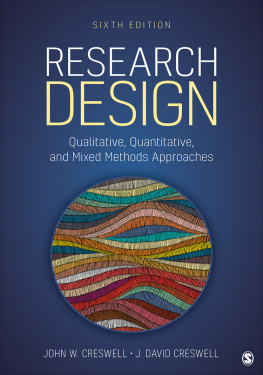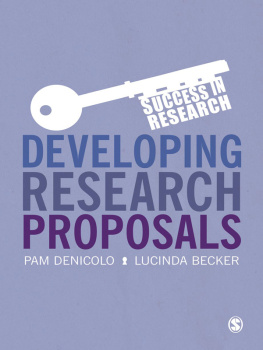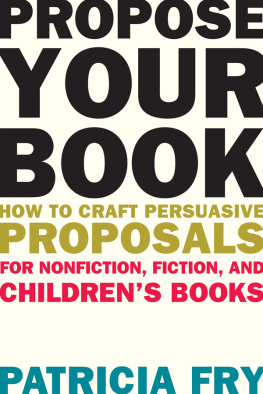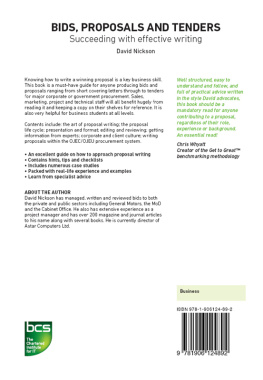PROPOSING EMPIRICAL RESEARCH
Proposing Empirical Research: A Guide to the Fundamentals provides step-by-step instructions for students who will be writing their first research proposal in the social and behavioral sciences and using both quantitative and qualitative methods.
The structure of the book enables students to work independently with confidence while writing the first drafts of their proposals. Each major section is divided into short topics and for each topic, students are asked to complete an exercise that leads them toward the goal of preparing a proposal. Numerous illustrative examples throughout the book make the recommendations for proposal writing come alive. In addition, the 10 model proposals provided at the end of the book illustrate proposal writing and provide material for classroom discussions.
New to the Sixth Edition:
Updates throughout to reflect research and learning in the digital/online environment, e.g., online surveys, digital organization tools, digital recruitment methods for research, and digital databases, records, and archives.
Discussion of qualitative methods.
Updated references, model proposals, end of chapter exercises etc.
Proposing Empirical Research is ideal for use in research methods classes where students write a proposal as a term project, thesis/dissertation preparation classes, senior research seminars where proposing and conducting research is a culminating undergraduate activity, and any graduate-level seminar in which the instructor wants to incorporate a project that will engage students in critical thinking about the content area.
Melisa C. Galvan is Assistant Professor at California State University, Northridge.
PROPOSING EMPIRICAL RESEARCH
Proposing Empirical Research: A Guide to the Fundamentals provides step-by-step instructions for students who will be writing their first research proposal in the social and behavioral sciences and using both quantitative and qualitative methods.
The structure of the book enables students to work independently with confidence while writing the first drafts of their proposals. Each major section is divided into short topics and for each topic, students are asked to complete an exercise that leads them toward the goal of preparing a proposal. Numerous illustrative examples throughout the book make the recommendations for proposal writing come alive. In addition, the 10 model proposals provided at the end of the book illustrate proposal writing and provide material for classroom discussions.
New to the Sixth Edition:
Updates throughout to reflect research and learning in the digital/online environment, e.g., online surveys, digital organization tools, digital recruitment methods for research, and digital databases, records, and archives.
Discussion of qualitative methods.
Updated references, model proposals, end of chapter exercises etc.
Proposing Empirical Research is ideal for use in research methods classes where students write a proposal as a term project, thesis/dissertation preparation classes, senior research seminars where proposing and conducting research is a culminating undergraduate activity, and any graduate-level seminar in which the instructor wants to incorporate a project that will engage students in critical thinking about the content area.
Melisa C. Galvan is Assistant Professor at California State University, Northridge.
Sixth edition published 2020
by Routledge
52 Vanderbilt Avenue, New York, NY 10017
and by Routledge
2 Park Square, Milton Park, Abingdon, Oxon, OX14 4RN
Routledge is an imprint of the Taylor & Francis Group, an informa business
2020 Taylor & Francis
The right of Mildred L. Patten and Melisa C. Galvan to be identified as authors of this work has been asserted by them in accordance with sections 77 and 78 of the Copyright, Designs and Patents Act 1988.
All rights reserved. No part of this book may be reprinted or reproduced or utilized in any form or by any electronic, mechanical, or other means, now known or hereafter invented, including photocopying and recording, or in any information storage or retrieval system, without permission in writing from the publishers.
Trademark notice: Product or corporate names may be trademarks or registered trademarks, and are used only for identification and explanation without intent to infringe.
First edition published by Pyrczak Publishing 2000
Fifth edition published by Routledge 2014
Library of Congress Cataloging-in-Publication Data
Names: Patten, Mildred L., author.
Title: Proposing empirical research : a guide to the fundamentals / Mildred L. Patten and Melisa C. Galvan.
Description: Sixth edition. | New York, NY : Routledge, 2020.
Identifiers: LCCN 2019018232 | ISBN 9781138615670 (hbk) | ISBN 9781138615632 (pbk) | ISBN 9780429463013 (ebk)
Subjects: LCSH: ResearchMethodology.
Classification: LCC Q180.55.M4 P378 2020 | DDC 001.4/2dc23
LC record available at https://lccn.loc.gov/2019018232
ISBN: 978-1-138-61567-0 (hbk)
ISBN: 978-1-138-61563-2 (pbk)
ISBN: 978-0-429-46301-3 (ebk)
Typeset in Stone Sans
by Wearset Ltd, Boldon, Tyne and Wear
To Emma Cristina, whose existence makes
every new day better than the last.
CONTENTS
Introduction to the Sixth Edition
Part A: Getting Started
Topic 1. What Is Empirical Research?
Topic 2. Identifying Broad Problem Areas
Topic 3. Evaluating Broad Problem Areas
Topic 4. Identifying and Combining Variables
Topic 5. Identifying Treatment Variables
Topic 6. Considering Demographic Variables
Topic 7. Writing Purposes and Hypotheses
Part B: A Closer Look at Problem Selection
Topic 8. Finding Ideas in the Literature
Topic 9. Considering a Body of Literature
Topic 10. Considering Theories and Frameworks
Topic 11. Determining Feasibility
Part C: Selecting a Research Approach
Topic 12. Qualitative Research
Topic 13. Survey Research
Topic 14. Correlational Research
Topic 15. Test Development Research
Topic 16. Experimental Research
Topic 17. Causal-Comparative Research
Topic 18. Program Evaluation
Part D: Organizing and Evaluating Literature
Topic 19. Organizing Literature by Topics
Topic 20. Evaluating Research Literature
Topic 21. Considering the History of a Topic
Part E: Application and Writing
Topic 22. A Separate Introduction
Topic 23. An Integrated Introduction and Literature Review
Topic 24. Writing the First Paragraph(s)
Topic 25. Using a Topic Outline
Topic 26. Being Selective and Critical
Part F: Proposing a Sample
Topic 27. Sampling in Qualitative Research
Topic 28. Random Sampling
Topic 29. Other Methods of Sampling: I
Topic 30. Other Methods of Sampling: II
Topic 31. Sample Size
Part G: Proposing Instrumentation
Topic 32. Qualitative Instrumentation
Topic 33. Proposing Published Instruments
Topic 34. Proposing New Instruments
Topic 35. Proposing to Measure Demographics
Topic 36. Ethical Issues in Measurement Methods
Part H: Proposing Procedures
Topic 37. Nonexperimental Procedures
Topic 38. Procedures in Experiments
Topic 39. Ethical Issues and Procedures
Part I: Proposing Methods of Analysis

